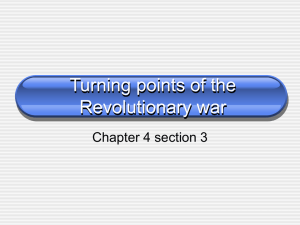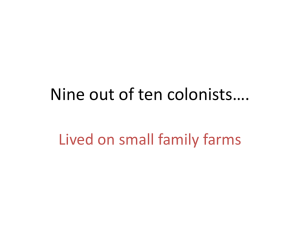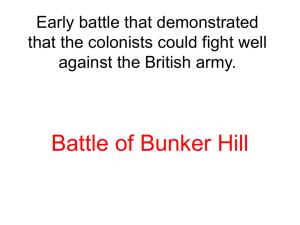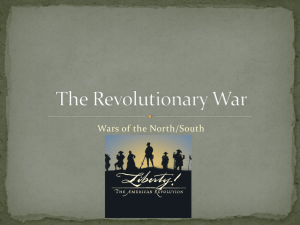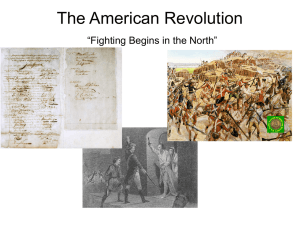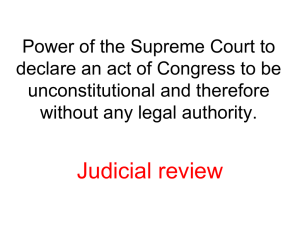Timeline of American Revolution PPT
advertisement
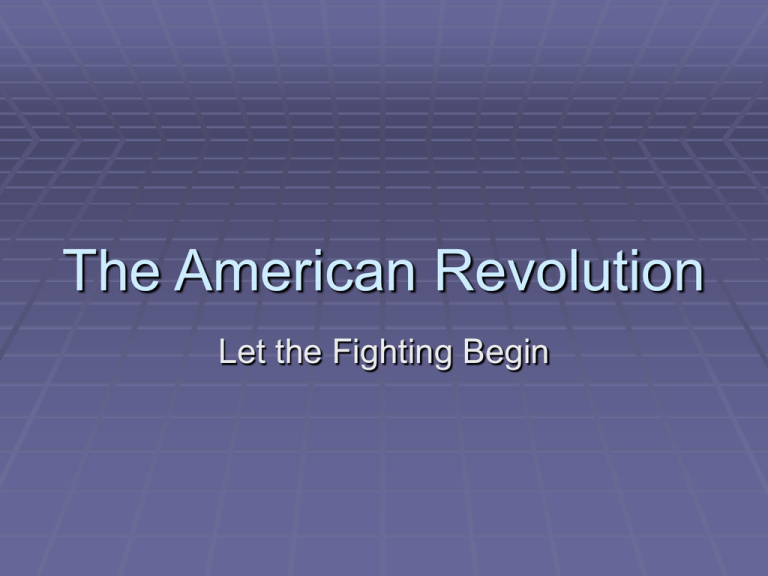
The American Revolution Let the Fighting Begin Pre-Test What was the Boston Tea Party? What were the Intolerable Acts,(the 4 provisions)? Pre-Test Why did the British go to Concord? After fighting with Minutemen in Lexington, marching to Concord and finding no arms and then starting the return trip to Boston, what happened to General Gages Redcoats? Pre-Test What will the Green Mountain Boys do at Fort Ticonderoga? What was the Olive Branch Petition? Pre-Test Who were the Redcoats? Who were the Loyalists? Who were the Patriots? Who were the Nons? Fuse to the Powderkeg Colonists disguised as Mohawk Indians boarded ships, split open tea chests and dumped them into Boston Harbor. An angry King George answers with the Intolerable Acts which closed Boston Harbor, forbade colonists from having more than one town meeting a year, permitted officials charged in Massachusetts to be tried in England and brought back the ever popular Quartering Act. Fuse to the Powderkeg The First Continental Congress would meet in September of 1774 and resolve to back Massachusetts in its struggle, agree to boycott British goods and stop exporting goods to Britain until the Intolerable Acts were repealed and urged each colony to set up its own militia. They agreed to meet again in May of 1775. Fuse to the Powderkeg General Gage planned to surprise Minutemen and their large store of arms in Concord. On April 18, 700 British troops left Boston under the cover of darkness for Concord. The Sons of Liberty were watching and placed two lamps in Old North Church signaling mounted messengers including Paul Revere to alert the Colonists that “The British were coming!” Fuse to the Powderkeg On April 19, The Red Coats reach Lexington just outside Concord and meet up with 70 Minutemen. Outnumbered, the Minutemen begin to leave when suddenly a shot rings out. Nobody knows who fired but when the dust cleared, 8 Colonists were dead and 1 British soldier was wounded. The British would push on to Concord. Fuse to the Powderkeg After finding no arms, the British head back to Boston but are stopped outside of Concord by Minutemen. Sharpshooters hiding in the woods and fields killed 73 British soldiers and another 200 were either missing or wounded after the altercation. After these battles, there was no turning back, war was the only answer. Minute Men, Red Coats, Lexington and Concord Who were Minute Men? What were the events that led to the fighting at Lexington? The Green Mountain Boys Ethan Allen was a Blacksmith known to have a horrific temper and noted as a man of action, led a band of men from Vermont (The Green Mountain Boys), led an attack on Fort Ticonderoga to appropriate needed cannons for the colonies. Fort Ticonderoga Ethan Allen was a popular man, full of character and a great natural leader. The British surrendered Fort Ticonderoga with little fight. Taking the fort gave the colonists much needed cannons and gunpowder and gave the colonists control of a key route into Canada. The Continental Army The Second Continental Congress took the step to set up the Continental Army. John Adams proposed that George Washington be appointed commander and was quickly approved. Pause in the Action Congress tried to patch things up with the crown and sent the Olive Branch Petition. The petition stated that if the King would repeal the Intolerable Acts, they would pledge their loyalty to him. King George III was enraged by the petition and the talk of independence vowing to bring rebel colonist to justice. Patriot Problems The American Colonists in favor of independence became know as Patriots. Disadvantages of American Patriots were that forces were poorly organized and trained and little gunpowder, few cannons and no navy. Patriot Assets Many Patriots owned guns and were good shots. They had a brilliant commander in Washington. The benefit of defending your own home and property. Know the area and landscape. British Advantages They had highly trained and experienced troops. They had the greatest navy in the world and could move troops quickly up and down the seaboard. Many colonists still supported the British. They were known as Loyalists. British Disadvantages Britain’s army was 300 miles away. News and supplies took months to travel from Britain to the Colonies. British soldiers risked attack from colonists when they marched from city to countryside. Loyalists, Tories and Nons Loyalists were also known as Tories. Tories made up about 20% of the colonists and included merchants and former officials of the royal government. Some farmers and craftworkers were also Tories. Loyalists, Tories & Nons More Loyalists lived in the Middle Colonies and the South as compared to New England. Loyalists were tarred and feathered and forced to leave their homes and farms. Nons were those colonists that held no loyalty to either side. Post-Test Who was Ethan Allen and what was his role at Fort Ticonderoga? What two things came out of the 2nd Continental Congress? Post-Test What was the Olive Branch Petition and what was King George’s response? Who were Patriots? Post-Test What were the advantages of the British going into the war? What were the advantages of the Colonists going into the war? The American Revolution Early Battles & The Declaration of Independence Pre-Test What was the first major battle of the American Revolution? What allowed the Americans to take Boston? Pre-Test What two cities did the Americans attack in Canada? What were the results? Who wrote Common Sense and what was its purpose? Pre-Test Who wrote the Declaration of Independence? What are the parts of the Declaration of Independence? The Battle of Blue Ridge Mountains The Battle of Blue Ridge Mountains was a skirmish at newly formed Old Fort North Carolina, in 1770. Colonists from the area “took over” the fort from British regulars under suspicious circumstances. Battle of Bunker Hill June 16, 1775, Col. William Prescott leads 1200 Minutemen up Bunker Hill across the river from Boston. He moves to Breeds Hill which is even better. From here he can fire upon British ships in the harbor. Battle of Bunker Hill The Minutemen dig in and at sunrise, British General Howe spots the Americans and along with 2400 redcoats crosses the harbor to mount an attack. Carrying heavy packs of over 100 lbs., the redcoats slowly climb towards the rebels. Battle of Bunker Hill Patriots patiently wait and having little gunpowder are warned to “don’t shoot till you see the whites of their eyes”. When the Patriots finally fired the British were forced to retreat. Battle of Bunker Hill The British were turned back a second time, but on the third try pushed over the top. This was the first major battle of the war and ended with over 1,000 redcoats killed and only 400 Patriots. The British Leave Boston Washington arrives at Boston a few weeks after Bunker Hill. He finds 16,000 raw recruits with makeshift weapons and turns them into trained soldiers and wins their trust and loyalty by his actions. British Leave Boston January of 1776 fortune arrives in the form of cannons brought from Fort Ticonderoga. The cannons would be placed on Dorchester Heights overlooking Boston Harbor. British Leave Boston When General Howe saw the cannons in place he knew he could no longer hold Boston. He leaves with Loyalist refugees and heads for Canada. King George will order blockades of all colonial ports. Montgomery Takes Montreal The Colonists would mount an attack on Canada hoping for help from French Canadiens, unhappy with British rule. In the fall of 1775, two American armies would move into Canada. Attack on Quebec Richard Montgomery will leave for Montreal and seize the city in November. Benedict Arnold would lead an army from Maine towards Quebec to meet Montgomery. Attack on Quebec Arnold’s troops faced rainstorms, freezing nights and supplies so low they ate tree bark and shoe leather. When they finally made it to Quebec, they found out that most French Canadiens did not support the Americans. Attack on Quebec December 31, 1775 in a blinding snowstorm the Americans attack. Montgomery is killed, Arnold is wounded and weak from disease and hunger the defeated Americans leave. Common Sense January 1776, Thomas Paine will write the Pamphlet “Common Sense”. Paine tried to convince colonists that they did not owe the King or Britain loyalty, and that separation was necessary. Declaration of Independence June of 1776, the Continental Congress forms a committee to form a declaration of independence that would tell the world why they should break away from Britain. The committee chooses Thomas Jefferson to write the document. Declaration of Independence On July 2, 1776 the Continental Congress votes that the 13 colonies are free and independent. July 4, 1776, delegates vote to accept Jefferson’s Declaration, which John Hancock boldly signs. Declaration of Independence The parts of the British wrongs – list of Declaration are… The preamble or introduction Natural rights – the rights that belong to all people from birth. wrongs committed by Britain and refusal to correct after being petitioned. Independence – announcement that the colonies had become the United States of America. Battle of Long Island Washington will head from Boston to New York, but is no match fro Howe’s 44,000 well trained soldiers and sailors. 1400 Americans are killed or wounded and the rest retreat to Manhattan. Battle of Long Island Howe chases Washington’s troops throughout the area and finally chases the Americans into Pennsylvania. Nathan Hale is used as a scout to get information on British, which he does. Nathan Hale Shortly after, Nathan Hale is captured by the British. As he goes to the gallows he makes the famous statement “I only regret that I have but one life to lose for my country”. Battle of Trenton On Christmas night, Washington will lead his troops across the Delaware River to surprise the Hessian troops guarding Trenton. The surprise worked and the Americans took most of the Hessians prisoner. Battle of Trenton Cornwallis immediately goes to retake Trenton. Washington fools the British by leaving the campfires burning and slipping behind the lines to attack Princeton, which they won. Does anybody remember the french and Indian War? Post-test Describe what happened at the Battle of Bunker Hill? What happened at the Battle of Quebec? Post-Test Describe the 4 parts of the Declaration of Independence? Who was Nathan Hale and what was his fate? Post-Test Who won the Battle of Long Island? What happened at the Battle of Trenton? How did Washington fool the British when they tried to retaliate? The American Revolution Turning the Tide & Winning the War Pre-Test What would be the turning point of the war? Describe the conditions at Valley Forge. What helped the men make it through the winter? Pre-Test What tactic did George Rogers Clark use to gain victory at Vincennes? What happened in the battle between the Bonhomme Richard & the Serapis? Pre-Test What was the role of women in the war? African Americans? What happened at the Battle of Cowpens, South Carolina? Pre-test What event marked the turn of Benedict Arnold into a traitor? What happened at the Battle of Yorktown? Burgoyne’s Plan Burgoyne believed that if the British cut off New England from the rest of the colonies, the war would soon end. The plan called for taking control of the Hudson River, stopping the flow of soldiers and supplies to Washington. Burgoyne’s Plan – (Fails) King George decided to change the plans and have General Howe capture Philadelphia first, he did. Burgoyne marching from Canada was pushed back by Benedict Arnolds troops and the plan stalls. Battle of Saratoga Through terrible hardships, carrying heavy baggage, Burgoyne takes Fort Ticonderoga. Needing supplies, he sends men into Vermont where he loses 1,000 men in the Battle of Bennington. Battle of Saratoga The Green Mountain Boys rush into New York to help and the Americans surround the British. Burgoyne now was trapped and had to surrender his whole army to the Americans. Battle of Saratoga The victory at Saratoga would end British threat to New England and boost patriot spirits at a time much needed. Most importantly, it would convince the French to join the fight. Help from Europe France would send the Marquis de Lafayette to train soldiers and would become one of Washington’s closest friends. The Prussians sent Friedrich von Steuben to drill and train troops. Help from Europe Polish officers Casimir Pulaski (sound familiar) trained the cavalry and Thaddeus Kosciusko helped build forts. Spanish governor of Louisiana supplied patriots with medicine, cloth muskets, gunpowder and sent cattle to feed soldiers. Valley Forge After Saratoga, Washington’s men winter at Valley Forge Pennsylvania. Terrible conditions – men freezing sleeping on frozen ground with little or no warm clothes and shoes with holes in them. Valley Forge As frostbite and disease set in, women collect food, clothing and medicine to send. Some, such as Martha Washington go to comfort the troops. Warm weather comes ending their bleakest hour. War in the West The British were more successful in gaining Native American aid. The British told Natives that Patriots would likely settle in their lands west of the Appalachian Mountains. The Northeast is just as bad and Iroquois and Loyalists raid settlements. Soon, Patriots will raid and destroy dozens of Iroquois villages. Victory at Vincennes George Rogers Clark plans a surprise winter attack on British fort at Vincennes. When he reached the fort, he spread his forces out in the woods to make their numbers look greater. Victory at Vincennes The British commander thought it useless to fight and surrenders in February of 1779. George Rogers Clark will become one of the biggest heroes of the area. Spanish Help Governor Bernardo de Galvez of Spanish Louisiana secretly supplies Patriots with medicine, cloth, muskets and gunpowder. He also sends cattle from Texas to feed troops. When they join the fight, they will seize British forts along Mississippi River and run them out of Florida. Battle of Moore’s Creek February 1776, North Carolina Patriots defeat Loyalists army. The South will be British target after failure in New York and New England. With Loyalists in the Backcountry, this strategy works for a while. Bonhomme Richard Britain controls the sea and blockades American ports. However, John Paul Jones commander of the Bonhomme Richard will disrupt the British in September 1779. Bonhomme Richard Jones spots merchant ships being protected only by the Serapis. A furious battle ensues with cannonballs ripping through the B. Richard. Jones utters famous words “I have not yet begun to fight” Bonhomme Richard Jones sails close to the Serapis so his men can board the ship. In hand to hand combat, the Americans take the ship and win the battle. Women in the War Women took care of things while men went to war. They tended and harvested crops and manufactured goods as well as taking care of regular chores. Some women went to war and cared for wounded, cooked meals and washed clothes. Betsy Ross, Molly Pitcher and others will gain some fame. African Americans in the War After British offer freedom to Africans, Washington changes policy to allow free blacks to enlist. About 5,000 African Americans some formed special units. Enslaved Africans had tough choice if help British could be hung by Patriots. Some Black Patriots as well as White Patriots such as James Otis hoped the war would end slavery. Battle of King’s Mountain Patriots succeed in capturing King’s Mountain on October 7, 1780. Jefferson states that “it breathes new life into the Patriot cause”. This turned the tide of cruel British & Loyalists attacks. Battle of Cowpens Generals Nathaniel Greene and Daniel Morgan will run Cornwallis’s forces ragged, by choosing to fight on grounds they held an advantage on and having boats ready for river crossings. Battle of Cowpens January of 1781 – General Morgan wins Battle of Cowpens. He orders troops to divide into a front line and a rear line. He orders front line to retreat after firing two volleys. Battle of Cowpens The British thinking the Americans were retreating, charge directly into the fire of the full brigade under Morgan’s command. Francis Marion or “The Swamp Fox” will lead bands of militia in guerilla warfare further frustrating the British. Victory at Yorktown Benedict Arnold will turn traitor in September of 1780 due to his lack of recognition and disagreement on the war efforts. Many are angered by his treason and call for his death. Cornwallis takes his attacks to Virginia and even runs of Legislature and Governor Jefferson from Charlottesville. Victory at Yorktown Cornwallis makes the mistake of not following orders of Sir Henry Clinton to send part of his troops to New York. He retreats to Yorktown Peninsula on Chesapeake Bay, confident British ships will supply his troops. Victory at Yorktown Washington and his Colonial troops along with Rochambeau and his French troops combine to join Lafayette in Virginia. French Admiral de Grasse takes Chesapeake Bay and shuts of supplies and escape routes. Victory at Yorktown By September 16,000 French and American troops pound Cornwallis and his outnumbered army. They hold out for several weeks, but with supplies running low, Cornwallis surrenders on October 19, 1781. Treaty of Paris II British recognize the United States as an independent nation. The borders of the new nation extend from Atlantic Ocean to Mississippi River, Southern border stops at Florida, which was returned to Spain. Americans agree to ask state legislatures to pay for property lost by Loyalists – most states will ignore. Reasons for American Victory Familiarity with the land – Geography. Assistance from other countries – particularly Spain, France and Prussia. Patriotic spirit and determination – the will to be free. The leadership of Washington was exceptional – and other leaders not bad either – think back. Washington’s Farewell December 1783, George Washington will ride off to Mount Vernon, with crowds cheering all along the way. Soon the country will call on Washington to lead the new nation onto the world stage. The End
